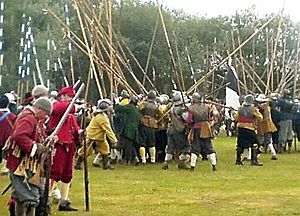Battle of Turnham Green facts for kids
Quick facts for kids Battle of Turnham Green |
|||||||
|---|---|---|---|---|---|---|---|
| Part of the First English Civil War | |||||||
 Modern-day reenactment of the battle |
|||||||
|
|||||||
| Belligerents | |||||||
| Commanders and leaders | |||||||
| Charles I Earl of Forth |
Earl of Essex Philip Skippon |
||||||
| Strength | |||||||
| 13,000 | 24,000 | ||||||
| Casualties and losses | |||||||
| 50 killed | 50 killed | ||||||
The Battle of Turnham Green happened on November 13, 1642. It took place near the village of Turnham Green in England. This battle was fought at the end of the first "campaigning season" of the First English Civil War. A campaigning season is the time of year when armies can easily move and fight.
The battle was a standoff between King Charles I's army and a much larger army of Parliamentarians. The Parliamentarian army was led by the Earl of Essex. Even though there was no clear winner in the fighting, the Parliamentarians achieved a big win. They stopped the Royalist army from reaching London. This forced King Charles and his soldiers to go back to Oxford for the winter.
Contents
What Was the Battle of Turnham Green?
The Battle of Turnham Green was a key moment in the early part of the English Civil War. It showed that the Parliamentarians could defend London. This city was very important for winning the war.
How Did the Battle Start?
After an earlier fight called the Battle of Edgehill, King Charles captured Banbury. He then arrived in Oxford on October 29, 1642, where he was welcomed by cheering crowds.
Royalist Advances and London's Fear
King Charles's nephew, Prince Rupert of the Rhine, was a strong cavalry (horse soldiers) commander. He rode through the Thames Valley, taking towns like Abingdon and Maidenhead. Rupert tried to capture Windsor but couldn't, as Parliamentarian forces there were too strong.
After this, many of the King's officers wanted to talk about peace. Prince Rupert wanted to keep fighting and go to London. The King agreed with his officers to try for peace talks. This gave the Earl of Essex time to prepare London's defenses with the Parliamentarian army.
On November 12, Prince Rupert's cavalry attacked Brentford. They then looted the town. This action made many Londoners, who worried about their homes and belongings, decide to support the Parliamentarians.
On November 13, the Earl of Essex's army gathered on Chelsea Field. This army included six groups of soldiers from the London Trained Bands. These were like local militias. Other London citizens also joined. Together, they formed an army of about 24,000 people. They marched to Turnham Green, where the main Royalist army was waiting.
What Happened During the Battle?
The Royalist army had about 13,000 soldiers. They were led by Patrick Ruthven, 1st Earl of Forth, and King Charles was also there. The Parliamentarian army, led by Essex, was much larger with 24,000 soldiers. Many of these were Londoners who had not fought in a battle before.
The two armies lined up facing each other, running roughly north to south. The Parliamentarian line was a bit longer than the Royalist one.
Why Didn't the Royalists Attack?
The Royalist army was greatly outnumbered. They also didn't have much ammunition. Because of this, they didn't want to attack. The King was also advised that attacking an army with so many armed citizens (like the London Trained Bands) would make Londoners dislike him even more. It was too early in the war for the Royalists to try to take London without some support from its people.
Since the fighting season was almost over, King Charles decided not to push for a full battle. He pulled his army back after a short exchange of cannon fire. Not many people were hurt on either side, with fewer than 50 killed in total.
The Parliamentarians took control of the battlefield without a full fight. This was probably good for them. Many of their soldiers had never been in a battle before. They were not used to army rules or how to move in formations.
Some, like John Hampden, wanted the Earl of Essex to try to surround the Royalist army. But experienced soldiers told Essex not to trust the Londoners to hold their ground while other troops moved. At this time, the London citizen soldiers were not strong enough to hold their position against Rupert's cavalry.
What Was the Result of the Battle?
King Charles, again going against Prince Rupert's advice, retreated back up the Thames Valley to Oxford. He missed a chance to move his army through Kent, a loyal area. Charles made Oxford his main base for the rest of the war.
After Turnham Green, the Royalists never again came so close to capturing London. Without taking London, they could not win the war.
Turnham Green Today
The area where the battle happened was once open fields. Now, it is part of the city of London, in the Chiswick area. Most of the original Turnham Green is gone. However, a small park still has the name. Another park, Back Common/Acton Green, keeps some of the open battlefield area. The Chiswick High Road (A315) still follows almost the same path as it did then. The Battlefields Trust has put up signs with information about the battle around the area.
Where Was the Battle Fought?
The Parliamentarian forces lined up from where the Turnham Green station is today, south to the grounds of Chiswick House. The original Chiswick House was built around 1610. The current house was built in the 1720s on the same spot. The Royalist line was a bit shorter. It started just south of today's Chiswick Park station and went south to where the Great West Road is now.

